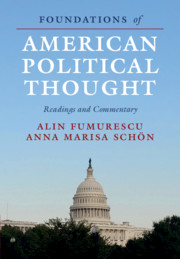46 results
Fanaticism: A Political Philosophical History. By Zachary R. Goldsmith. Philadelphia: University of Pennsylvania Press, 2022. 196p. $49.95 cloth.
-
- Journal:
- Perspectives on Politics / Volume 21 / Issue 2 / June 2023
- Published online by Cambridge University Press:
- 01 June 2023, pp. 716-718
- Print publication:
- June 2023
-
- Article
- Export citation
5 - Independence
-
- Book:
- Foundations of American Political Thought
- Published online:
- 09 July 2021
- Print publication:
- 29 July 2021, pp 134-177
-
- Chapter
- Export citation
Copyright page
-
- Book:
- Foundations of American Political Thought
- Published online:
- 09 July 2021
- Print publication:
- 29 July 2021, pp iv-iv
-
- Chapter
- Export citation
6 - The Positive Founding (I)
-
- Book:
- Foundations of American Political Thought
- Published online:
- 09 July 2021
- Print publication:
- 29 July 2021, pp 178-225
-
- Chapter
- Export citation
4 - The Puritans
-
- Book:
- Foundations of American Political Thought
- Published online:
- 09 July 2021
- Print publication:
- 29 July 2021, pp 91-133
-
- Chapter
- Export citation
9 - People That Were Left Behind
-
- Book:
- Foundations of American Political Thought
- Published online:
- 09 July 2021
- Print publication:
- 29 July 2021, pp 317-358
-
- Chapter
- Export citation
Index
-
- Book:
- Foundations of American Political Thought
- Published online:
- 09 July 2021
- Print publication:
- 29 July 2021, pp 402-406
-
- Chapter
- Export citation
2 - Republicanism
-
- Book:
- Foundations of American Political Thought
- Published online:
- 09 July 2021
- Print publication:
- 29 July 2021, pp 13-48
-
- Chapter
- Export citation
Acknowledgements
-
- Book:
- Foundations of American Political Thought
- Published online:
- 09 July 2021
- Print publication:
- 29 July 2021, pp xiv-xiv
-
- Chapter
- Export citation
Contents
-
- Book:
- Foundations of American Political Thought
- Published online:
- 09 July 2021
- Print publication:
- 29 July 2021, pp v-x
-
- Chapter
- Export citation
Preface
-
- Book:
- Foundations of American Political Thought
- Published online:
- 09 July 2021
- Print publication:
- 29 July 2021, pp xi-xiii
-
- Chapter
- Export citation
1 - Introduction
-
- Book:
- Foundations of American Political Thought
- Published online:
- 09 July 2021
- Print publication:
- 29 July 2021, pp 1-12
-
- Chapter
- Export citation
8 - The Whole and the Parties
-
- Book:
- Foundations of American Political Thought
- Published online:
- 09 July 2021
- Print publication:
- 29 July 2021, pp 272-316
-
- Chapter
- Export citation
7 - The Positive Founding (II)
-
- Book:
- Foundations of American Political Thought
- Published online:
- 09 July 2021
- Print publication:
- 29 July 2021, pp 226-271
-
- Chapter
- Export citation
3 - Liberalism
-
- Book:
- Foundations of American Political Thought
- Published online:
- 09 July 2021
- Print publication:
- 29 July 2021, pp 49-90
-
- Chapter
- Export citation
10 - The United States “Is”
-
- Book:
- Foundations of American Political Thought
- Published online:
- 09 July 2021
- Print publication:
- 29 July 2021, pp 359-401
-
- Chapter
- Export citation

Foundations of American Political Thought
- Readings and Commentary
-
- Published online:
- 09 July 2021
- Print publication:
- 29 July 2021
6 - “This Is Essentially a People’s Contest”
-
- Book:
- Compromise and the American Founding
- Published online:
- 28 August 2019
- Print publication:
- 05 September 2019, pp 174-216
-
- Chapter
- Export citation
Acknowledgments
-
- Book:
- Compromise and the American Founding
- Published online:
- 28 August 2019
- Print publication:
- 05 September 2019, pp vii-viii
-
- Chapter
- Export citation
2 - The Uncompromising Puritans
-
- Book:
- Compromise and the American Founding
- Published online:
- 28 August 2019
- Print publication:
- 05 September 2019, pp 27-65
-
- Chapter
- Export citation



